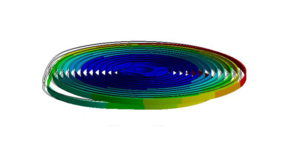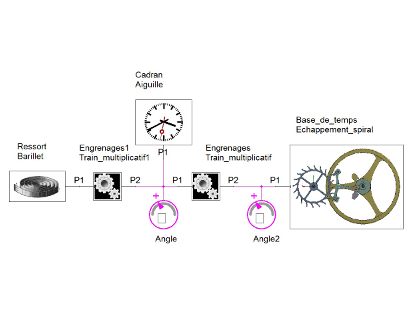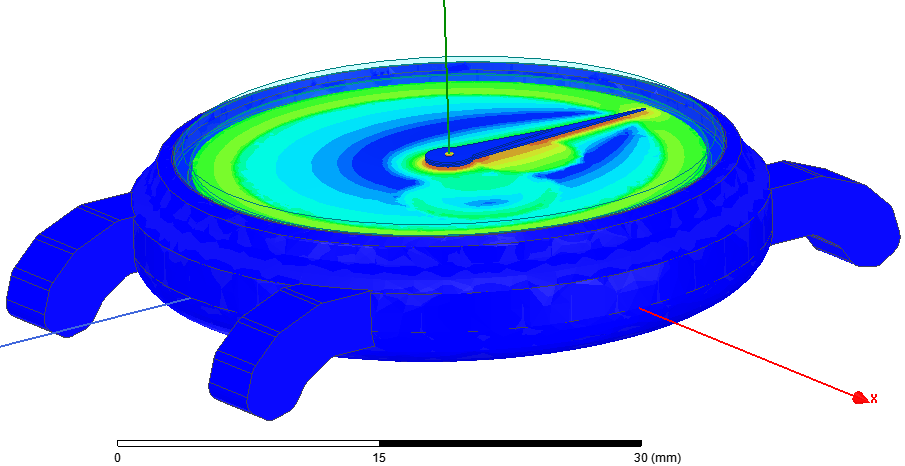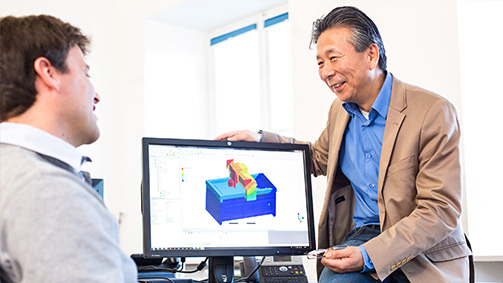Watch simulation
CADFEM has acquired over the past ten years a recognized expertise in the simulation of watch parts and mechanisms. Our watchmaking experience allows us not only to support you in the implementation of simulation in your company but also to make this tool, as quickly as possible, productive in order to significantly reduce the number of prototypes.
precise watch simulation
Experience for the watchmaking industry
Recognized by the watch industry for its experience in watch calculation, CADFEM (Suisse) AG's team of engineers has been sharing its simulation know-how with watch manufacturers for 20 years. It provides watchmakers with effective tools to perform complex simulations, design more reliable products, accelerate the development process and reduce the research budget.
Indeed, simulation with Ansys facilitates the creation of many virtual prototypes, in a controlled environment where all physics are managed. These can be coupled together to facilitate the work of developers. To ensure that watch calculation is an efficient tool that is fully integrated into your research and development processes, the CADFEM team will guide you through your projects with local support.
Fields of Application
Ansys allows you to check the strength of the parts and calculate the forces and torques acting in your assembly during the entire design stage.

Static analyses

Dynamic analysis

Fluid analysis

Electromagnetic analysis

Acoustic analysis

Reliability and optimization

Smart watch

Optical simulation for watch industry
Watch box sealing and stress
The behavior of the box under pressure is studied in the framework of a structural static analysis. The first step is to simulate the assembly of the box (ice chasing, bottom assembly), so as to start from a realistic situation in terms of pre-stressing and geometry of the deformed joints. Pressure is then applied to the outer surfaces. At the joints, the extent to which water will penetrate can be simulated by activating the "pressure penetration" option. Ansys calculates the contact pressure at the joints and adapts the water penetration area accordingly, which in turn influences the contact pressure. This gives an extremely realistic picture of the deformation of the joints under pressure and the extent to which water penetrates. The following information can be obtained in this way:
- Is the box watertight or not?
- margin of tightness (by comparing contact pressure / water pressure)
- Visualization of the behavior of the seal (zoom, cuts etc... in reality you can't see what is going on inside, or you need transparent components, but changing the material also changes the behavior)
- Deformations and stresses in all parts
- Residual deformations when getting out of the water (example: plastic deformation on a bottom that would be too thin. How much is it when getting out of the water?). Through iterations or optimization, one can thus by obtain an optimal thickness of the bottom; as thin as possible (for a light watch and to reduce the manufacturing costs) but as thick as necessary.
This is a relatively standard calculation. It is not simple for a beginner in self-training, but with our assistance, anyone, even without experience, can be quickly operational regarding this issue.
Simulation of an elastomeric bracelet
Simulation of an elastomeric bracelet. The aim is to first carry out numerical tests to identify critical areas and risks of failure, whether in tension, torsion or a combination of both. The simulation can also include the fastening mechanism.This type of simulation is accessible to everyone, including beginners.
CADFEM drives you to the optimal result thanks to available trainings or “Guided work” sessions.
Calibre spring
With Ansys Mechanical, simulate the maximum stresses in a rocker spring, its pre-arming and arming, and get the resulting torque. Modeling benefits from the advanced capabilities of contacts in Ansys, such as friction due to contact slippage. In addition, large displacements and deformations can be simulated simply. Dimension a spring on the computer to match your specifications.
Static structural calculation of a rotating bezel
The torque required to rotate the steady rest is calculated, and must neither be too high (difficult to rotate) nor too low (could rotate with the sleeve of the shirt). At the same time, we calculate the stresses, which must be low enough to avoid problems of plastification or breakage.
Through various geometric iterations, directly coupled with Ansys, a geometry that meets the specifications is obtained very quickly. A sensitivity analysis can then be carried out; what happens with a higher or lower friction coefficient? With a thicker/wider blade than nominal? With a greater or lesser pre-stress? One can identify the parameters with the greatest influence and ensure the robustness of the system.
The analysis can also be completed :
- by a fatigue analysis: how many cycles before fatigue failure?
- by considering wear, either by directly simulating the wear phenomenon, or by estimating the wear and simulating the behavior (new values of torque, stress, etc.) of the worn system.
- by additional load cases. E.g.: what happens if we try to turn the bezel in the wrong direction? Can this cause the spring to plasticize or break? How much torque would it take to damage the spring?
The simulation therefore allows an optimized and robust geometry to be obtained. Quick and relatively simple, this type of calcul is open to all, including beginners.
Bolt assessment for watchmakers
An in-depth study of watch screws was carried out by HE Arc using the Ansys-CADFEM Bolt Assessment Inside Ansys extension. This extension makes it possible to obtain the results of stresses a more detailed and direct manner, while also obtaining the risk of unscrewing the screws depending on the load cases analyzed. It is then very clear which screws meet or do not meet the criterion studied.

Simulation wear of a jumper
A watch mechanism may work perfectly when it leaves the factory, but then not work after a certain time, due to the deterioration of the surface conditions. Use numerical simulation to easily evaluate the influence of friction coefficients. While keeping the established model, you can simply modify the value of the friction coefficient (typically between 0.05 and 0.2) to obtain new values of stresses and torques for a deteriorated surface condition and thus ensure the robustness of the design. You can also address wear issues. Getting a design that leads to lower contact pressures (measured by numerical simulation) will allow you to reduce wear. By importing worn geometry you can better interpret the consequences of wear on torques and stresses. On the basis of physical tests, a wear law can also be obtained (calibration of the Archard model). It will allow you to anticipate the expected wear for new components: the model calculates a wear rate and adapts the mesh to it. You can then identify the most deteriorated areas and, as before, obtain stresses and torques on the worn geometry, to finally ensure the robustness of the design.
Static simulation of pull-out piece
Simulation is not reduced to the management of two or three components. The ideal is to be able to directly simulate parts of entire mechanisms. The new prestressing management features make it easy to set up preloads. Contacts are efficiently managed and even free components with running clearances can be simulated. The displacement of parts can be imposed exactly as in reality and the influence on other components can be seen and quantified in a single simulation. The user can study the model in 2D to obtain extremely fast calculation times (between 30s and 10min on a laptop) or switch to 3D to take into account out-of-plane considerations.
Dynamic analyses
Multi-body simulation of chronograph
The dynamic modulus allows you to simulate the movement of rigid bodies and the exact deformation of flexible bodies such as the springs of a chronograph mechanism. It is thus possible to model the reset, start/stop, loading of the return springs, forces on the pusher and the operation of a virtual prototype. Changes and tests on new variants are made directly using the software Ansys Motion. Thus, the following information can be obtained:
- Forces required at the pushers.
- Dynamics: stabilization time of the hand when resetting to zero by means of the hammer-core system.
- Stresses in the flexible components (e.g. spring) while considering the influence of dynamics and possible out-of-plane behavior.
- Possible sensitivity study, e.g. what happens with higher friction coefficients? (aging), influence of operating clearances...
- influence of operating sets ...
Optimization of a magic pawl
The magic pawl allows to wind the barrel whatever the direction of rotation of the oscillating weight. Indeed, with the watchmaking simulation, we can quickly calculate the number of teeth jumps at each oscillation as well as the constraints on the pawl blades. The realization of geometrical variants, manual or automated, in the Ansys software, allows to identify the most relevant parameters and to improve the performance and the robustness of the system.
Reducer study
The simulation of the reducer must be based on contacts in order to be able to determine the efficiency of the system under operating conditions and to see the influence of backlash. Simulation with Ansys Motion (multi-body tool, here with rigid bodies) allows very low calculation times (10s of calculation, laptop, 4CPUs) whereas the simulated physical time is 80s. These low calculation times are a prerequisite for sensitivity studies (influence of manufacturing tolerances, 6 sigma study, etc.) and optimisation studies.
Swiss anchor exhaust
The escapement is the master system of a watch caliber. Isochronism depends on it, and its performance directly influences the power reserve of the watch. Ansys enables the evaluation and optimization of the escapement on multiple aspects:
- evaluation of the escapement's performance,
- determination of the maximum amplitude of the balance wheel,
- determination of the quality factor of the balance in a flat or hanging position, taking into account both air friction (obtained by CFD analysis) and friction at the level of the stones and counter-stones (structural dynamic analysis, friction coefficients determined initially by calibration on measurements),
- influence of the spiral: inertia, radial forces during the winding-release cycle,
- transient behaviors during the flat-to-hung transition, or during shocks,
- influence of the diameter of the stones, the point of attachment of the balance spring, etc.
- study of flexible escapements.
Calculation of the friction of a pendulum
Dynamic simulation with Ansys LS-Dyna taking into account the flexible spring and rigid bodies. This simulation makes it possible to quantify the friction losses over several periods and thus the logarithmic decrement and then the quality factor of the balance, according to its orientation in relation to gravity. A geometric variant was also studied. Dish and Hanged positions.
Simulation of the deformations of the bracelet
Bracelets with links can be simulated with Ansys LS-Dyna, regardless of the shape and number of links. Ansys LS-Dyna can manage the interaction between links, shank, case, screws, pins, etc... We can thus obtain by simulation:
- the shape of the bracelet (flat, around the wrist),- the distribution of forces: at which links, which screws, etc., are they at their maximum, depending on the load case (traction, torsion, combination of both),
- stress values, possibility to transfer the results into a structural static model for even more accuracy on the most critical components,
- any type of material can be considered (steel, gold, etc.).
- The objective is to reduce development time by obtaining an operational geometry through simulation before starting the manufacturing and final validation through physical testing.
Simulation of a clockwork ball bearing
To perform a structural dynamic simulation, many contacts and backlashes must be managed. This simulation is performed to show feasibility.
Shock simulation
You want to simulate the result of a fall from a height of one meter on the elements of a watch. The dynamic module will apply an acceleration on the components (dial, fixing flanges, movement, flanges) and then calculate their deformations during the impact. It is also possible to observe the stress of the flanges and screws and study the influence of the parameters during the impact. In this example, 17 parts are modeled and 48 contacts are created.
System approach
Study of mechanisms as systems. The system created with the Simplorer add-on software highlights the dynamic evolution including inertia and flexibility of certain parts, energy transmission, synchronization effects, transmission delays, and energy balance.

Fluid calculation
Fluidic calculation is important in the watchmaking world to characterize the proportion of air damping or the effects of surface tension and lubrication viscosity.
Damping of a pendulum by air resistance
The calculation of the air flow around the balance provides the resistive torque due to viscous friction, disturbances due to the passage under the balance bridge, the location of the maximum friction zones, the contribution of each part.
Contact with an oil film
The simulation makes it possible to calculate the dynamics of oil films in the contact areas and to extract, among other things, the very precise evolution of the force acting on the parts.
Electromagnetic calculation
The parasitic forces due to the application of a magnetic field to the mechanical components of the watch can be calculated to meet or exceed the anti-magnetic watch standard.
Magnetic field in the watch
The calculation of the shielding of the magnetic field by the watch allows to know the local field acting effectively on the critical components. This simulation facilitates analysis and the search for probable interferences before the production of a prototype.
Stepper motor
The transient electromagnetic analysis of the Lavet motor gives access to the dynamic behaviour of the motor, which makes it possible to study the influence of many parameters such as, for example, the evolution of the current in the coil over time, the friction on the axis, the inertia of the rotor, the geometry, the materials chosen etc.
Behaviour of a spiral spring subjected to a magnetic field
The purpose is to quantify the effects of magnetic fields on the operation of a spiral spring. We have the result here in the following cases:
- magnetization in a constant field
- magnetic remanence after exposure to an external magnetic field
- deformations due to persistent magnetic forces

Acoustic simulation
Acoustic calculation makes it possible to examine and adjust the timepiece from a digital model reproducing the physical characteristics of the prototype to be built. Optimize the timepiece according to the parameters of your model.
Timepiece
Ansys allows advanced acoustic studies! You can define excitations on the rooms and calculate the acoustic waves radiated in the surrounding air. Such a numerical study of the possible configurations of the watch timbre (geometry, materials, excitations) allows you to develop a thorough understanding of the phenomena influencing sound. In this example, we obtain a time signal allowing the extraction of different spectra over time and the sound produced.
Sound wave diffusion
Once the acoustic calculation is complete, you can visualize the diffusion of sound waves in the air.
Listen to the watchmaker's stamp
Once the acoustic calculation is complete, you can listen to the sound of the watch timbre produced according to the characteristics defined for this calculation.
Characterizing tone with Ansys Sound
The extraction of various parts of the spectrum over time (waterfall diagram) makes it possible to distinguish between attack and resonance, background noise and tonal parts, and to translate this sensation into quantitative values.
Robust optimization of a pull spring
Carried out in 3 steps with the Optislang module, the robust optimization calculation aims to provide an optimal and robust solution based on the chosen parameters, taking into account tolerances, variations on materials, loads, etc. Find a shape that provides predefined tensile and pushing forces on the pin while minimizing maximum stress. The desired forces are obtained with an accuracy equal to that of the model. Robust 4.5 sigma pull tab for the stress field in the part. These results are obtained with Ansys optiSLang.
Topologic optimization
The objectives for watch development are often clear. But how do you find the geometry that meets the specifications?
Structural topology optimisation with Ansys will surely help you find the answer.
The concept is that the software identifies the important structural areas for you; rather than making a design by hand, evaluate it, modify it, re-evaluate it and continue iteratively.
Example 1: You want to create a skeleton bridge, light, hollow but above all robust, based on the load case (5,000 g shocks, for example). Ansys then identifies the stress transmission areas, retains the material in these areas for maximum stiffness and removes the less stressed elements.
The result is a lighter but stronger geometry. In the Innosuisse bridge project presented here, the part is produced by additive manufacturing. In this context, the topological optimisation tool is optimal. Indeed, having new manufacturing capabilities makes sense if one can also design differently. However, it is also possible to ask the Ansys solver to ensure an extrudable geometry (ideal for machining or cutting on plates) or compatible with stamping or pressing. Thus, topology optimisation is perfectly suited to conventional methods.
Example 2: You wish to balance a needle-wheel-core system by removing material from the wheel, without changing the aesthetics of the needle. As before, simply indicate the load cases (torsion, bending) for which the rigidity must be maximised and give an acceptable tolerance for the position of the centre of gravity. The solver then removes the unnecessary elements for the load bearing capacity. In this simulation, a whole series of constraints were entered: in manufacturing with minimum thicknesses and a need for extrudable geometry, and in design with symmetry to be respected. The solver respects all the constraints imposed.



Smart watch
As the Internet of Things (IoT) market expands, the speed of bringing new connected objects to market is crucial to be competitive. The creation of a virtual multi-physical prototype accelerates the design of such a product.
With Ansys, simulate an entire virtual prototype, with multi-physical calculations (mechanical, high frequency electromagnetic, thermal, electronic). The use of simulation anticipates problems related to production, use and accelerates time to market.
Discover in the commented video the different calculation steps and tools proposed by Ansys.
Optical simulation for watch industry
Optical simulation enlight watch Industry
Physical optical simulation with Ansys Speos (ray tracing) makes it possible to account for the interactions between surrounding light and product in order to anticipate the optical experience in situations such as living rooms, concert halls, laboratories, studios etc...
The following aspects can be considered in particular: refraction, reflections and diffusions in the crystal, reflections according to the state of surface on cases or on engravings, fire in precious stones, the possibility of reading the dial according to the environment and the orientation of the watch.
The environment, like a case whose influence is fundamental, can be represented both by predefined light sources and by detailed customized environments based on photographs or from databases (for example in .hdri format). Ansys Zemax (geometric optics) or Ansys Lumerical (photonics) complete the Ansys Speos (formerly Optis) functionalities.
Example of a watch developed with optical simulation - Ansys Speos
Using Ansys Speos optical design simulation software and guided by CADFEM, XRby was able to innovate watch concepts, test various watch assemblies and rapidly evaluate aesthetic options, assessing more than 100 precious materials and elements. With Speos texture mapping, for example, engineers were able to forecast how watch materials behave under different lighting conditions, an essential step in determining which glass box material would best control light diffraction, light reflection and image distortion. Ultimately, they selected sapphire crystal.(Extract from Ansys blog Jan 2021)
Example of a watch developed with optical simulation - Ansys Speos
Using Ansys Speos optical design simulation software and guided by CADFEM, XRby was able to innovate watch concepts, test various watch assemblies and rapidly evaluate aesthetic options, assessing more than 100 precious materials and elements. With Speos texture mapping, for example, engineers were able to forecast how watch materials behave under different lighting conditions, an essential step in determining which glass box material would best control light diffraction, light reflection and image distortion. Ultimately, they selected sapphire crystal.(Extract from Ansys blog Jan 2021)
On Demand
Get a deeper understanding of our solutions by taking advantage of our on demand offer.
Watchmaking training courses
These training courses are based on concrete cases from the watchmaking world. Based on our experience in watch calculation, in the different physics, we transmit our know-how to you, adapted to your specific applications.
The right solutions for your simulation projects
Simulation is everywhere and affects every industry. Since simulation requires more than software, CADFEM offers everything you need for successful simulation from a single source: software and IT solutions, consulting, support, engineering and knowledge sharing – always on the cutting edge.




































